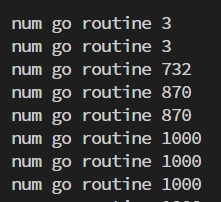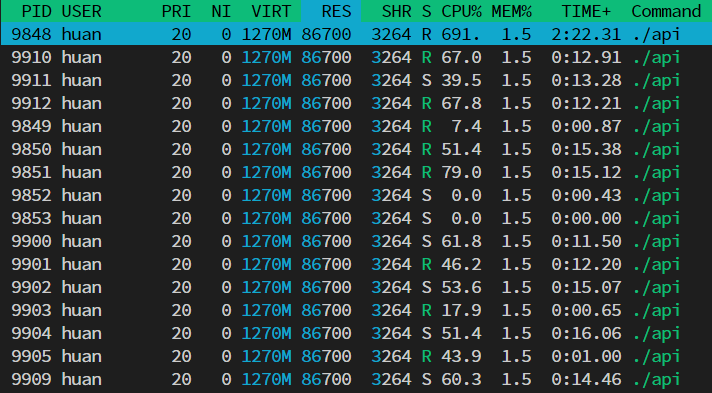How to reduce the memory usage from 897MB to 87MB while maintaining the same performance.
this is a toy api server as performance comparsion between Go and Rust demonstrated in https://www.youtube.com/watch?v=MY3Ou5ehwUQ&ab_channel=VagelisProkopiou.
Came across the video and found the number very interesting.
As someone who knows a bit about Go but knows nothing about Rust, I was quite suprised about how much the memory usage difference. So I wanted to take a closer look.
Now I have cloned the project and build the project as below:
$ go version
go version go1.18.3 linux/amd64
$ go build -o api .
$ ./api
┌───────────────────────────────────────────────────┐
│ Fiber v2.23.0 │
│ http://127.0.0.1:3000 │
│ (bound on host 0.0.0.0 and port 3000) │
│ │
│ Handlers ............. 2 Processes ........... 1 │
│ Prefork ....... Disabled PID ............. 19578 │
└───────────────────────────────────────────────────┘
I started wrk similar to how it's done in the video:
$ wrk -t6 -c1000 -d60s http://localhost:3000/api/v1/users
Running 1m test @ http://localhost:3000/api/v1/users
6 threads and 1000 connections
Thread Stats Avg Stdev Max +/- Stdev
Latency 104.05ms 104.54ms 1.31s 86.98%
Req/Sec 2.01k 397.97 4.93k 72.67%
719292 requests in 1.00m, 71.53GB read
Requests/sec: 11965.50
Transfer/sec: 1.19GB
During the mean time this is the memory usage I observed with htop:
897MB, even more than the usage shown in the video. I assume the difference is mainly because of the go version. But the point still stands: Tho the RPS is very good, the memory usage is high.
Reading through the code one thing quickly stands out:
[1000]User
This is an array in Golang, not actually something I come across very frequently, more often I use slice.
One can easily find a million articles about the difference between array and slice, but whats important here is:
Array is passed by vaule whereas Slice is passed by reference (1.)
So lets change that:
-func getUsers() [1000]User {
+func getUsers() []User {
...
-return users
+return users[:] // https://go.dev/ref/spec#Slice_expressionsNow this is the result again:
wrk -t6 -c1000 -d60s http://localhost:3000/api/v1/users
Running 1m test @ http://localhost:3000/api/v1/users
6 threads and 1000 connections
Thread Stats Avg Stdev Max +/- Stdev
Latency 154.04ms 187.97ms 1.97s 84.13%
Req/Sec 1.93k 552.97 4.32k 69.61%
690719 requests in 1.00m, 68.69GB read
Socket errors: connect 0, read 0, write 0, timeout 1
Requests/sec: 11493.62
Transfer/sec: 1.14GB
Basically the same RPS (the difference is most likely errors), but now the memroy usage dropped from 897MB to 276MB. Not bad for 2 lines of code change if you ask me.
Now I am too hung up on this tiny example, makes me thinking can the mem usage reduce further?
Based on my understand of Goroutine (2.) and how http server wors in Golang in general, once the socket is accepted, it is handed over to a goroutine to handle the request in user defined handler, in this case c.JSON(getUsers()).
Once the handler finished processing the request it needs to write back to the socket, which is a potentially blocking operation, by then Go runtime will park the current goroutine and give its cpu power to some other goroutine to process the request, and wake up the parked goroutine once the socket is writeable. The whole thing is managed by something like epoll behind the scene. (3.)
BUT the polling and write to socket operation compare with allocating memory and generating JSON is stil SLOW.
So what is happening is the speed of processing the request is larger than the speed of writing (finish) the response, so more and more goroutiens are spawned. Till the point of the concurrency level set in wrk, which is 1000.
Meaning that there are 1000 Gorouting creating the [1000]User at the same time. Intuitively that would take quite a bit memory to hold 1000 * 1000 User structs and their strings.
And lets see if thats true by adding this snippet:
go func() {
for {
fmt.Println("num go routine", runtime.NumGoroutine())
time.Sleep(time.Second)
}
}()it will print the number of goroutines every second.
Run wrk again and this is what looks like:
It quickly reaches 1000.
Now given this simple example, it is inevidible to have faster request processing than response writing. We could limit the max number of goroutine created when handling requests, but that would need peakig into the framework used (fiber), to see if it is even supported to do that kind of configuration.
So another way is to still have the framework spin up goroutine, but we dont allocated the memory if there are already enough requests in-flight.
And here is the change:
+ctx := context.TODO()
+sem := semaphore.NewWeighted(int64(runtime.GOMAXPROCS(0)))
+
app.Get("/api/v1/users", func(c *fiber.Ctx) error {
+ sem.Acquire(ctx, 1)
+ defer sem.Release(1)
return c.JSON(getUsers())
+})Result:
num go routine 1000
wrk -t6 -c1000 -d20s http://localhost:3000/api/v1/users
Running 20s test @ http://localhost:3000/api/v1/users
6 threads and 1000 connections
Thread Stats Avg Stdev Max +/- Stdev
Latency 90.22ms 14.06ms 467.32ms 91.94%
Req/Sec 1.79k 174.42 2.27k 80.89%
214633 requests in 20.09s, 21.35GB read
Requests/sec: 10683.82
Transfer/sec: 1.06GB
With still 1000 goroutines (as explained above), slightly decreased RPS, we now
only use 87MB.
Now I think I've picked all the easy wins out of this toy api server, it's only nature to ask, can it use even less memory?
It sure can.
As said the framework still spawns goroutines even tho we are only processing it at maximum runtime.GOMAXPROCS concurrently. So if we can limiting the number of goroutines spawned to process request, we can save 4KB (4.) per goroutine, and thats about 4MB savings.
Better? Profiling every function call to elimiate any wasteful allocates.
Even more (or, less)? Dont use a framework and hand rolling the reqest handler using low level epoll directly, like https://github.com/tidwall/evio
...
I am pretty happy with 90% usage decrease in this example already :)
1. Technically Slice is also passed by value, but it is pasing a SliceHeader value which contains pointer to the underlying backing array, thus no heavy mem copy involved.
2. My understanding might not be accurate.
3. A good article about go-netpoller https://www.sobyte.net/post/2022-01/go-netpoller/
4. stack size for a goroutine https://stackoverflow.com/questions/22326765/go-memory-consumption-with-many-goroutines



